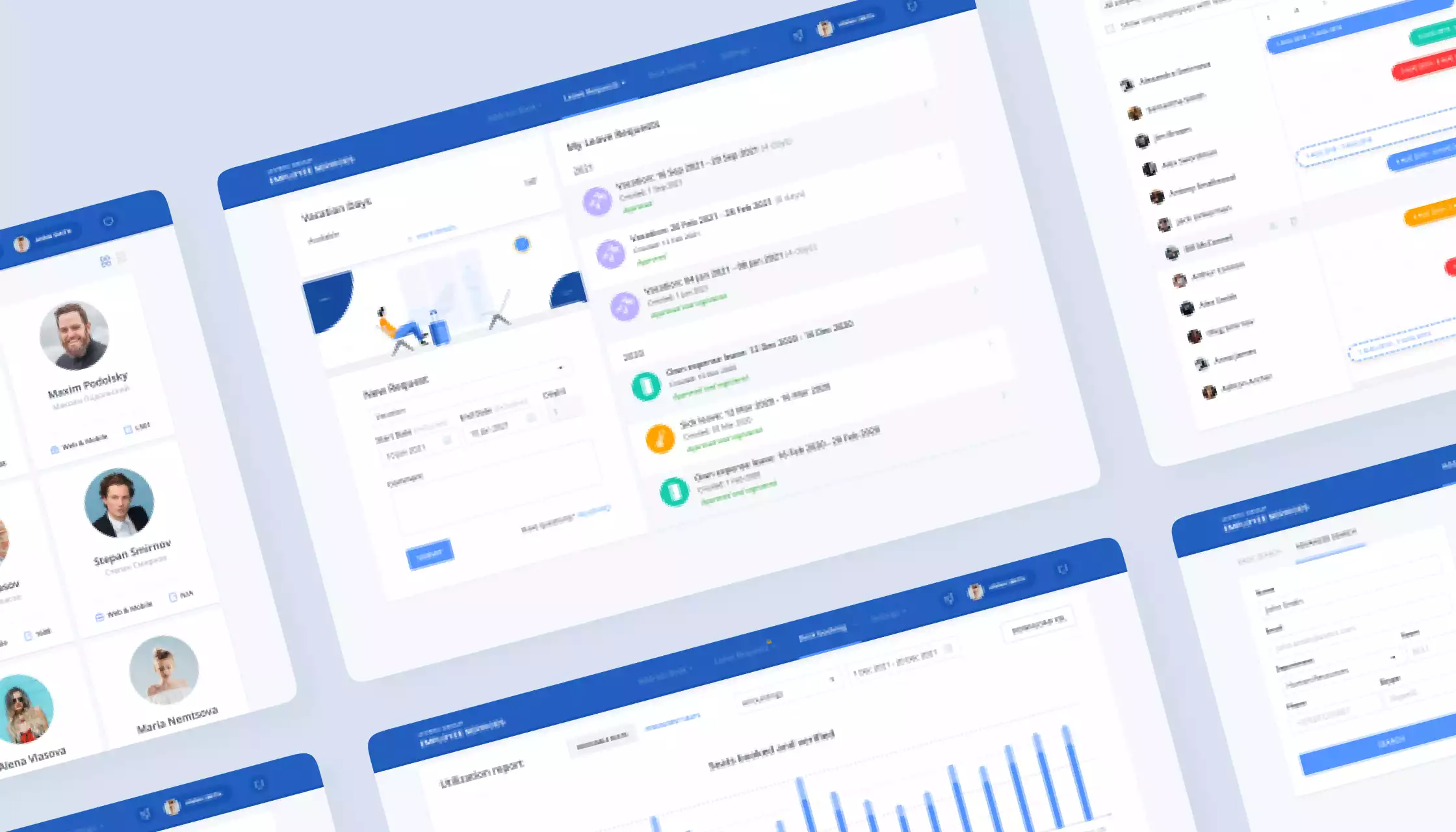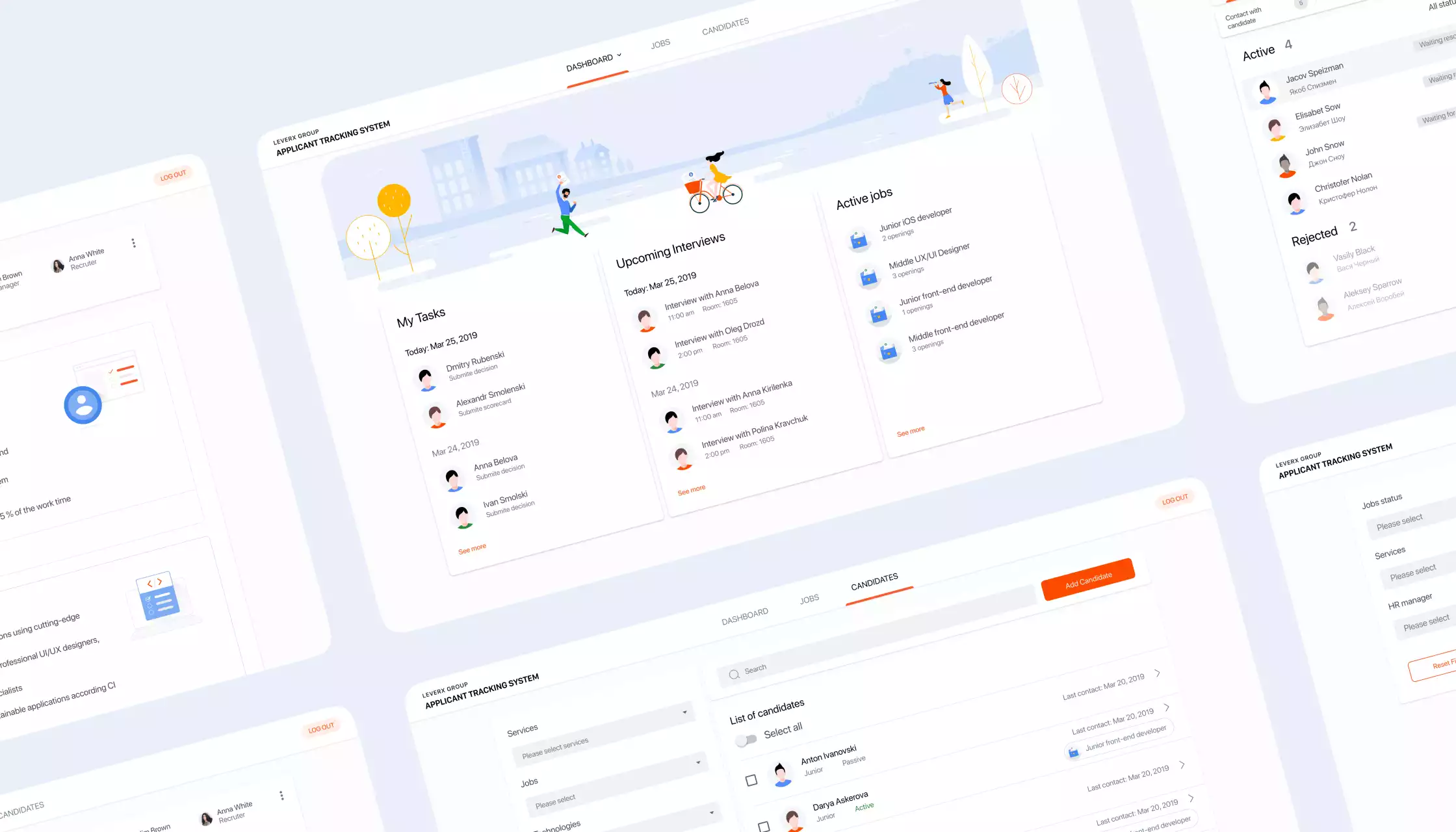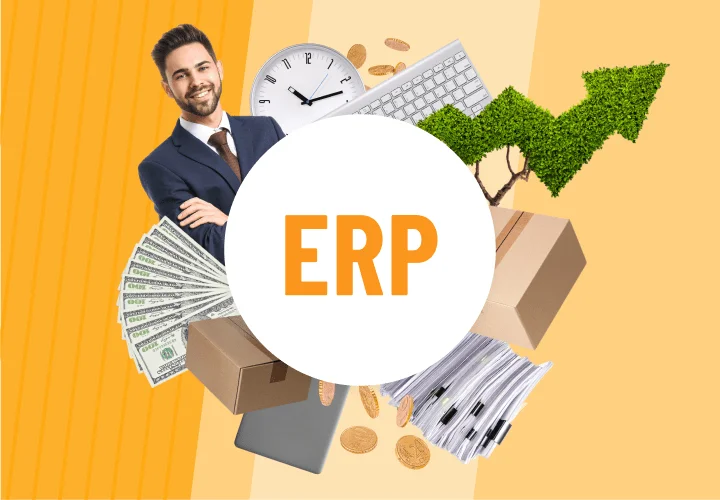HR Automation: Drive Efficiency in Recruiting & Keep Remote Employees Engaged
Table of contents
- What HR Processes Should You Automate?
- Three Software Solutions That Address HR Automation Challenges
- 1. Employee Training and Engagement
- Espresa — Web Platform for Benefits Management
- 2. Time Off & Leave Management
- LES — Cloud-Based Solution for Employee Management
- 3. Candidate Recruiting
- ATS — Software for Electronic Document Flow in HR Departments
Business process automation is no longer a privilege but a necessity. PwC’s HR technology survey reports that cloud HR solutions bring a lot of benefits to businesses, including a 44% increase in efficiency, 35% reduced costs, 40% improvement in employee experience, etc.
No matter whether an organization is large or small, operating in retail, healthcare, or other industries, they deal with human resources. Most HR processes are manual and time-consuming, which results in low productivity and performance.
In our blog post, we’ll look into the issue and provide three software solutions that will help organizations with HR automation.
What HR Processes Should You Automate?
Below are the factors that will help you identify the processes that require automation within your organization:
- High-volume but low-complexity tasks
- Repeated processes
- Multiple people assigned to work on a single task
- Time-consuming routine operations
- Need for consistency and compliance with internal regulations
- Need for eliminating errors
If any of your business processes match the above-mentioned factors, you’ll probably need to automate them. To provide you with a clear understanding of what kind of human relations processes are typically automated, we’ve prepared the infographics below.

Three Software Solutions That Address HR Automation Challenges
Based on our research, we defined three common challenges that businesses have to meet when managing human resources. To address them, we suggest three examples of HR software designed and built by Emerline’s team.
1. Employee Training and Engagement
With the COVID-19 pandemic, most organizations had to transfer their operations online. According to the survey completed by Mckinsey, executives say that their companies responded to a range of COVID-19-related changes much more quickly than they thought possible before the crisis. For example, it was expected that organizations might need 454 days to respond to remote working and collaboration, while in reality, it took 10.5 days.
To adapt to the new reality, businesses had to build or restructure their internal workflow processes to stay as efficient as they had been prior to the lockdowns. Most of the processes are now performed through cloud-based software solutions online, including team collaboration, employee training, onboarding, social events announcements, etc. So, how can you keep employees engaged in the company’s activities while working from home? How can you arrange meetups and training that used to be held offline? How can you continue to take advantage of social benefits such as sports and social events?
The web platform below will help companies address all the challenges related to employee engagement during WFH.
Espresa — Web Platform for Benefits Management
When it comes to training and employee engagement, businesses can leverage Espresa for managing, ordering, and paying for onsite services provided for employees as part of a social benefits package.
The platform includes six modules that cover the tasks performed by human resource and benefits teams:
- Employee Resource Groups: creating and maintaining formal and informal groups connecting employees in a virtual space.
- Meetings and Events: creating virtual employee meetings, meetups, office hour slots, multi-track events, and gym schedules.
- Wellbeing and Fitness: delivering onsite and offsite classes for employees.
- Reimbursements and Allowances: creating and managing reimbursement programs for employees, regardless of their location and currency used.
- Challenges and Achievements: rewarding employees for participation and promotion of your company’s activities.
- Rewards and Recognition: recognizing the achievements of employees.
2. Time Off & Leave Management
Manual processing of leave requests is difficult and time-consuming, as HR specialists need to review available leave days, get the approval of a project manager, and add records of leave for payroll calculation. Considering the multistep nature of this process, it makes it difficult to process the request on time.
With automation, HR leave management can be faster, while records are more structured and consistent. Automated leave approval systems help HR departments save time on contacting each project manager in person because approvers receive leave requests once a request is submitted. This can also help to keep and handle employee leave records more efficiently, as they are updated instantly. Below you’ll find an example of how leave and time-off management can be automated.
LES — Cloud-Based Solution for Employee Management

LES is a 2-in-1 employee management system with an address book and a vacation tab. It’s applied for processing vacation leave and keeping contact and general info about employees within a single platform that can be accessed by any employee within the company.
- Address Book
Users need to sign in with a Google account to access the Address Book. It offers two options for searching contact information about colleagues, including basic and advanced. The former allows finding a colleague by name, while the latter — by email, department, room, phone, and Skype name.
- Leave Request
The Leave Request component is used for submitting requests for being absent from work and keeping records on any type of leave, be it a vacation, sick leave, work from home, military leave, or maternity leave. The system enables automated calculation of the requested days, depending on the type of leave. Integration with Jira helps to automate the process of approval by project leads.
- Desk Booking
A year of remote working forced a lot of businesses to rethink traditional work models. According to Microsoft’s 2021 report, 73% of employees surveyed expressed a desire for flexible remote work options post-pandemic, and 66% of businesses said they were considering redesigning physical spaces to better accommodate hybrid work environments. We are among those who’ve been adopting a flexible working model, that's why we designed a desk booking feature to implement into our corporate employee management system. How do our employees benefit from it?
Employees can book a desk via the LES system by opening the Desk Booking tab. It allows choosing a desk from the list of available rooms, workplaces, and locations. After the request is processed, the confirmation is automatically sent to the employee’s email. Being available in the cloud environment, it can be used from any location, no matter where an employee is, whether in the office or working from home.
Now many companies are trying to bring their teams back to the office. Since the comfort of our team has always been and remains one of the top priorities, our employees can continue working from home. To address this up-to-date challenge, we designed the Desk Booking feature to integrate with our employee management system. Having been deployed in the cloud environment, it allows our employees to book a desk from home, office, or any other location. Dmitry Novik, LES Project Manager
3. Candidate Recruiting
Before a candidate is hired by an organization, recruiters need to find, attract, and recruit new talent. Since this multi-step process is ongoing, it requires the automation of regular, time-consuming activities. Automating talent acquisition tasks will help your HR staff perform them faster and efficiently manage recruitment processes within your organization.
What talent acquisition tasks can be automated?
- Pre-screening candidates
- Parsing CVs based on specific criteria
- Scheduling interviews
- Analyzing CVs for the best match with the job requirements
Here’s an excellent example of a software solution delivered by our HR software development company that can automate recruiting management tasks.
ATS — Software for Electronic Document Flow in HR Departments

HR specialists often face situations when candidates apply later, even if they rejected the offer or their skills didn’t match with a particular vacancy. So, how do you reduce the recruitment process for those candidates? To address this challenge and others when historical records about candidates are required, our team built an applicant tracking system.
ATS is a software solution for HR departments to maintain a unified candidate database and automate the workflow. The system allows the tracking of all recruitment operations starting from the first contact to a successfully passed probation period. Ensuring a convenient electronic document flow, the software helps to eliminate repetitive tasks and refocus your time on more strategic tasks.
With ATS, HR specialists can:
- Get incoming job openings from the heads of departments placed in the internal system and proceed with finding potential candidates.
- Maintain a centralized database of candidates for easy access to the information about them.
- Add new information about candidates both manually and automatically.
Wherever you are on your BPA project, Emerline’s team will help you deliver your project on time. Being flexible to our client’s needs, we work on different engagement models. If you have a project idea in mind, feel free to contact us.
Published on Mar 3, 2023





